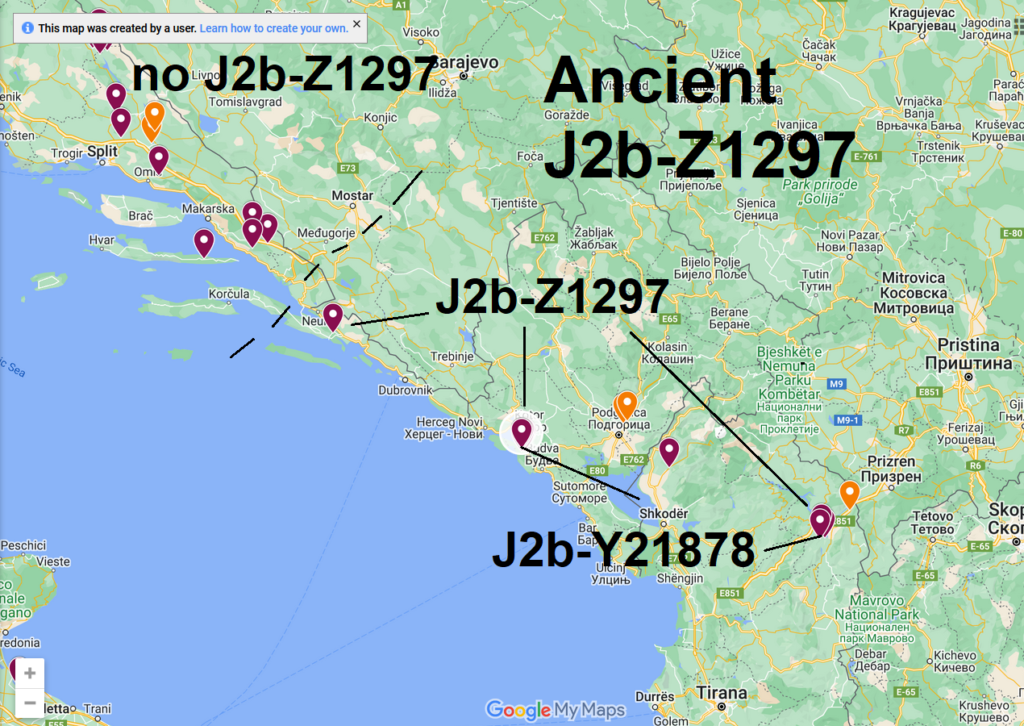
Recently, 1100 BCE ancient sample I13167 from Montenegro was added to the YFull YTree. This sample is represented with the Kotor Municipality code but was found more specifically in a tumulus grave at Velika Gruda archaeological site. This data was released as part of the Lazaridis et al. (2022) study.
This sample is positive for a SNP at the level of J2b-Y21878, one of two children of J2b-Z1295.
There were five other J2b-L283 samples at this site with lower coverage. Noteworthy is that one of these, I13169, dating to 1339 BCE, is confirmed positive for J2b-Z1297 and negative for a SNP at the J2b-Y21878 and J2b-Y27522 levels.
Another high resolution sample from this study was found in Çinamak, Albania, dating to 531 BCE and also positive for J2b-Y21878>CTS11100>Y37121.
I am not an expert on the different prehistoric cultures of this region but in this article I draw some broad geographic working assumptions regarding J2b-Z1297 and downstream origins based on this find and based on the absence of J2b-Z1297 being yet found elsewhere in such an ancient context.
However I will link to this Wikipedia article about Illyria proprie dicti because it appears that the approximate geography of Veliki Gruda would have fallen within the state or political grouping referred to as 'properly called Illyrians' by Pliny the Elder and Pomponius Mela.
This differentiates the term Illyrian from other wider geographic or ethnographic definitions that encompass much of the western Balkans.
J2b-Z1297 more likely originated somewhere closer to Dalmatia-Dubrovnik and the Coast of Montenegro rather than in previously sampled areas further NW along Dalmatian Coast
This working assumption proceeds from the fact that the only Bronze Age or Iron Age ancient samples positive for J2b-Z1297 have been found in Dalmatia-Dubrovnik or further to the southeast along the Adriatic coast.
One to two dozen samples have been found from further northwest along the Adriatic coast and none are positive for J2b-Z1297. Of those, none have yet to be confirmed negative for J2b-Z38240 (that is to say all with calls are positive for Z38240).
J2b-Z1297 vs J2b-Z1295 origin not possible to disambiguate based on ancient samples yet found
Unfortunately, the single Bronze Age ancient sample from Dalmatia-Dubrovnik (Gudnja Cave) on the YFull YTree at the J2b-Z1297 position had no call for Z1295, nor any of its immediately downstream subclades.
Since this sample could actually be from any number of downstream branches, we have no basis on which to make further deductions regarding origin of J2b-Z1297 vs J2b-Z1295.
Similarly we would need more high resolution samples found from Gudnja Cave to compare its J2b-L283 diversity to Velika Gruda.
Where are ancient J2b-Y21045, J2b-Y27522 and J2b-Z8421 samples "hiding"?
If we take 3100 ybp as an approximate cutoff for the Bronze Age / Iron Age transition, then there are five lineages of J2b-Y21045 that existed before that time.
J2b-Y27522 has only three. Prolific J2b-Y23094 has 1100 BCE TMRCA. So before that time this prolific line was not prolific - it was just one man.
J2b-Z8421 has only two. Prolific J2b-Z631 has 900 BCE TMRCA. Unless the YFull estimate is off, we shouldn't expect to find any fully formed J2b-Z631 in the Bronze Age though there should be dozens of lineages existing by the Iron Age.
Supposedly a Serbia study and Albania study will soon come out so I think we have a high potential of finding Bronze and Iron Age samples in these lineages in Serbia and Albania.
Other promising areas on the periphery of established ancient J2b-L283 diversity include Hungary, Bosnia and Herzegovina, Montenegro, Kosovo and North Macedonia. I think we could find interesting discoveries from western Bulgaria and western Romania as well.
I don't expect much ancient J2b-L283 from Ancient Greece
There is no strong basis to assume any significant Bronze Age or Iron Age diversity of any J2b-L283 line will be found in Greece perhaps excepting the areas in the NW of Greece or Ionian Islands where some living J2b-L283 trace their descent.
The only sample on YFull marked Grevena, Greece is a sample tracing his male line to the village of Lavdas to an ethnic group known as Koupatsarei. This group is described as likely having descended from sedentarized Vlachs in this paper. This particular sample is positive for J2b-Z631>Z1043>FT33373 and is equally distantly related to men from elsewhere in the western Balkans (Slovenia, Albania and Bulgaria so far). So his ancient ancestors may have have originated somewhere further northwest than Grevena.
I'll discuss the new developments in this branch in a separate article.
The term Illyria proprie dicti is used to indicate “Illyrian” tribes which where not celtinized in dress or customs.
It is not a term for origin of race , this term seems to confuse many.
The oldest “illyrian” site is the Unesco site in the Port of Vienna dating 1600BC …………….not the city of Vienna a celtic city circa 500BC.
In regards to placing the most southern tribe of the Illyria proprie dicti …the Taulantii would be around the bay of Lissos….south of them is Durres , created between 700-733BC by the corinthians after their conquest of Liburnian owned Corfu.
Durres would also fit as the most northern Pyrrhus the Epirote city and his kingdom and also fit the Philip V of Macedon invasion and Destruction of the Taulantii around the bay of Lissos.
regards